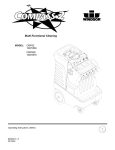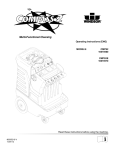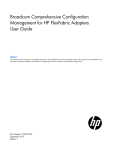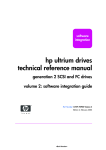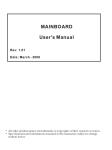Download PCA-6179 - Fairchild Engineering Ltd
Transcript
PCA-6179 Full-size socket 370 Intel® Pentium® III processorbased PCI/ISA-bus CPU card Copyright notice This document is copyrighted, 2000, by Advantech Co., Ltd. All rights are reserved. Advantech Co., Ltd. reserves the right to make improvements to the products described in this manual at any time without notice. No part of this manual may be reproduced, copied, translated or transmitted in any form or by any means without the prior written permission of Advantech Co., Ltd. Information provided in this manual is intended to be accurate and reliable. However, Advantech Co., Ltd. assumes no responsibility for its use, nor for any infringements upon the rights of third parties which may result from its use. Acknowledgements • AWARD is a trademark of AWARD Software, Inc. • IBM and PC are trademarks of International Business Machines Corporation. • Intel® and Pentium® III are trademarks of Intel Corporation. • MS-DOS is a trademark of Microsoft Corporation. • SMC is a trademark of Standard Microsystems Corporation. • WinBond is a trademark of Winbond Corporation. • SYMBIOS is a registered trademark of Symbios, Inc. • ATI is a registered trademark of ATI Technologies, Inc. • VIA is a registered trademark of VIA Technologies Inc. All other product names or trademarks are the properties of their respective owners. Part No. 2006617903 3rd Edition Printed in Taiwan Jan. 2001 A Message to the Customer Advantech customer services Each and every Advantech product is built to the most exacting specifications to ensure reliable performance in the harsh and demanding conditions typical of industrial environments. Whether your new Advantech equipment is destined for the laboratory or the factory floor, you can be assured that your product will provide the reliability and ease of operation for which the name Advantech has come to be known. Your satisfaction is our primary concern. Here is a guide to Advantech’s customer services. To ensure you get the full benefit of our services, please follow the instructions below carefully. Technical support We want you to get the maximum performance from your products. So if you run into technical difficulties, we are here to help. For the most frequently asked questions, you can easily find answers in your product documentation. These answers are normally a lot more detailed than the ones we can give over the phone. So please consult this manual first. If you still cannot find the answer, gather all the information or questions that apply to your problem, and with the product close at hand, call your dealer. Our dealers are well trained and ready to give you the support you need to get the most from your Advantech products. In fact, most problems reported are minor and are able to be easily solved over the phone. In addition, free technical support is available from Advantech engineers every business day. We are always ready to give advice on application requirements or specific information on the installation and operation of any of our products. PCA-6179-00A1 Series comparison table Model PCA-6179L-00A1 PCA-6179V-00A1 PCA-6179VE-00A1 PCA-6179VS-00A1 PCA-6179F-00A1 CPU: Intel®Pentium® III Socket 370 ✓ ✓ ✓ ✓ ✓ System chipset: VIA Apollo Pro 133 A ✓ ✓ ✓ ✓ ✓ BIOS: Award P&P Flash BIOS ✓ ✓ ✓ ✓ ✓ L2 Cache: 256 KB (on CPU) ✓ ✓ ✓ ✓ ✓ Max. System RAM: 1.5 GB (3 x 168-pin sockets) ✓ ✓ ✓ ✓ ✓ ISA High Drive: up to 64 mA ✓ ✓ ✓ ✓ ✓ USB Port 2 2 2 2 2 2 EIDE connectors ✓ ✓ ✓ ✓ ✓ Solid state disk: DOC© 2000 ✓ ✓ ✓ ✓ ✓ 2 serial, 1 parallel ports ✓ ✓ ✓ ✓ ✓ VGA: AGP/VGA (ATI RAGE128 PRO™ 4 XL) ✕ ✓ ✓ ✓ ✓ LAN: 10/100Base-T Ethernet (chipset: Realtek 8139C) ✕ ✕ ✓ ✕ ✓ Ultra 2 SCSI (SYM53C895) ✕ ✕ ✕ ✓ ✓ VGA RAM ✕ 8MB 8MB 8MB 8MB PCA-6179-02A1 Series comparison table Model PCA-6179V-02A1 PCA-6179VE-02A1 PCA-6179F-02A1 CPU: Intel®Pentium® III Socket 370 ✓ ✓ ✓ System chipset: VIA Apollo Pro 133 A ✓ ✓ ✓ BIOS: Award P&P Flash BIOS ✓ ✓ ✓ L2 Cache: 256 KB (on CPU) ✓ ✓ ✓ Max. System RAM: 1.5 GB (3 x 168-pin sockets) ✓ ✓ ✓ ISA High Drive: up to 64 mA ✓ ✓ ✓ USB Port 2 2 2 2 EIDE connectors ✓ ✓ ✓ Solid state disk: DOC© 2000 ✓ ✓ ✓ 2 serial, 1 parallel ports ✓ ✓ ✓ VGA: AGP/VGA (ATI RAGE128 PRO™ 4 XL) ✓ ✓ ✓ LAN: 10/100Base-T Ethernet (chipset: Realtek 8139C) ✕ ✓ ✓ Ultra 2 SCSI (SYM53C895) ✕ ✕ ✓ VGA RAM 32MB 32MB 32MB Initial Inspection Before you begin installing your card, please make sure that the following materials have been shipped: • 1 PCA-6179 socket 370 Pentium III® processor-based single board computer • 1 Pentium III® processor (optional), 1 cooling fan, P/N: 1759205400 • 1 PCA-6179 startup Manual • 1 CD driver utility and manual (in PDF format) • 4 SCSI driver disks (optional) • 1 FDD cable, P/N: 1701340703 • 2 UDMA 66 HDD cables, P/N: 1701400452 • 1 printer (parallel port) cable & COM port cable kit, P/N: 1700060305 • 1 ATX-to-PS/2 power cable, P/N: 1700000450 • 1 ivory cable for PS/2 keyboard and PS/2 mouse, P/N: 1700060202 • 1 SCSI cable (optional), P/N 1701060000 • 1 USB cable (optional), P/N 1700100170 If any of these items are missing or damaged, contact your distributor or sales representative immediately. We have carefully inspected the PCA-6179 mechanically and electrically before shipment. It should be free of marks and scratches and in perfect working order upon receipt. As you unpack the PCA-6179, check it for signs of shipping damage. (For example, damaged box, scratches, dents, etc.) If it is damaged or it fails to meet the specifications, notify our service department or your local sales representative immediately. Also notify the carrier. Retain the shipping carton and packing material for inspection by the carrier. After inspection, we will make arrangements to repair or replace the unit. Contents Chapter 1 Hardware Configuration .............................. 1 1.1 1.2 1.3 Introduction ........................................................................2 Features ...............................................................................3 Specifications ......................................................................5 1.3.1 System .........................................................................5 1.3.2 Memory .......................................................................5 1.3.3 Input/Output ................................................................6 1.3.4 VGA interface .............................................................6 1.3.5 SCSI interface .............................................................6 1.3.6 Ethernet LAN ..............................................................6 1.3.7 Solid state disk ............................................................6 1.3.8 Industrial features .......................................................7 1.3.9 Mechanical and environmental specifications ............7 1.4 Board Layout: Main Features ..........................................8 1.5 Jumpers and Connectors ...................................................9 1.6 Board Layout: Jumper and Connector Locations ....... 11 1.7 Safety Precautions ............................................................12 1.8 Jumper Settings ................................................................13 1.8.1 How to set jumpers ...................................................13 1.8.2 CPU clock ratio setting (SW1) .................................13 1.8.4 CMOS clear (J1) ................................................................15 1.8.5 Watchdog timer output (J2) ......................................15 1.8.5 DiskOnChip® 2000 Flash disk address select (SW3) ....16 1.9 System Memory ................................................................18 1.9.1 Sample calculation: DIMM memory capacity ................18 1.9.2 Supplementary information about DIMMs ..............19 1.10 Memory Installation Procedures ....................................20 1.11 Cache Memory .................................................................20 1.12 CPU Installation ...............................................................21 Chapter 2 Connecting Peripherals ............................ 23 2.1 Primary (CN1) and Secondary (CN2) IDE Connectors24 2.2 Floppy Drive Connector (CN3) .......................................25 2.3 Parallel Port (CN4) ..........................................................25 2.4 SCSI Connector (CN5) ....................................................26 2.5 USB Port (CN6) ................................................................27 2.6 VGA Connector (CN7) ....................................................27 2.7 10/100Base-T Ethernet Connector (CN8) ......................28 2.8 Serial Ports (CN9: COM1; CN10: COM2) ....................28 2.9 PS/2 Keyboard and Mouse Connector (CN11) .............29 2.10 External Keyboard Connector (CN12) ..........................29 2.11 Infrared (IR) Connector (CN13) ....................................30 2.12 CPU Fan Connector (CN14) ...........................................30 2.13 Front Panel Connectors (CN16, CN17, CN18, CN19, CN21 and CN22) .........................................................................31 2.13.1 Keyboard lock and power LED (CN16) .................31 2.13.2 External speaker (CN17) ................................................31 2.13.3 Reset (CN18)...........................................................31 2.13.4 HDD LED (CN19) ..................................................32 2.13.5 ATX soft power switch (CN21) ..............................32 2.14 ATX Power Control Connectors (CN20 and CN21) .....32 2.14.1 ATX feature connector (CN20) and soft power switch connector (CN21) ...................................................32 CN20 32 2.14.2 Controlling the soft power switch ...........................33 Award BIOS Setup........................................................ 35 3.1 3.2 3.3 3.4 Introduction ......................................................................36 Entering Setup ..................................................................36 Standard CMOS Features ...............................................37 Advanced BIOS Features ................................................38 3.4.1 Virus Warning ..........................................................39 3.4.2 Quick Power On Self Test ........................................40 3.4.3 Boot Up Floppy Seek ................................................40 3.4.4 Boot Up NumLock Status .........................................40 3.4.5 Gate A20 Option .......................................................40 3.5 3.6 3.7 3.8 3.9 3.10 3.11 3.12 3.13 3.14 3.4.6 Typematic Rate Setting .............................................40 3.4.7 Typematic Rate (Chars/Sec) .....................................41 3.4.8 Typematic Delay (msec) ........................................... 41 3.4.9 Security Option .........................................................41 3.4.10 OS Select for DRAM > 64MB................................ 41 3.4.11 Video BIOS Shadow ...............................................41 3.4.12 C8000-CBFFF Shadow / DC000-DFFFF Shadow .42 Advanced Chipset Features.............................................42 3.5.1 Memory Hole At 15 M ~ 16 M .................................43 3.5.2 AGP Aperture Size (MB) .......................................... 43 Integrated Peripherals .....................................................43 3.6.1 IDE HDD Block Mode .............................................43 3.6.2 IDE Primary Master/Slave PIO/UDMA Mode, IDE Secondary Master/Slave PIO/UDMA Mode (Auto) ..44 3.6.3 Onboard FDC Controller .......................................... 44 3.6.4 Onboard Serial Port 1 (3F8H/IRQ4) .........................44 3.6.5 Onboard Serial Port 2 (2F8H/IRQ3) .........................44 3.6.6 Onboard Parallel Port (378H/IRQ7) .........................44 3.6.7 Parallel Port Mode (ECP + EPP) .............................. 44 3.6.8 ECP Mode Use DMA ...............................................45 Power Management Setup ..............................................45 3.7.1 Power Management ..................................................46 3.7.2 HDD Power Down ....................................................46 3.7.3 Soft-Off by PWR-BTTN ........................................... 46 3.7.4 Wakeup Event ...........................................................47 3.7.5 IRQs Activity Monitoring .........................................47 PnP/PCI Configurations ..................................................48 PC Health Status ..............................................................48 Frequency Control ...........................................................49 Load Setup Defaults .........................................................49 Set Password .....................................................................49 Save & Exit Setup ............................................................50 Exit Without Saving .........................................................50 Chapter 4 AGP SVGA Setup ....................................... 51 4.1 4.2 4.3 Before You Begin .............................................................52 Features .............................................................................52 Installation ........................................................................53 Chapter 5 LAN Configuration ..................................... 55 5.1 Introduction ......................................................................56 5.2 Features .............................................................................56 5.3 Driver Installation ............................................................57 5.4 Windows 9X Drivers Setup Procedure ....................................................................................58 5.5 Windows NT Drivers Setup Procedure ..........................65 5.6 Windows 2000 Drivers Setup Procedure .......................70 Chapter 6 SCSI Setup and Configurations................ 77 6.1 6.2 6.3 tion 6.4 6.5 6.6 Introduction ......................................................................78 Before You Begin .............................................................78 Basic Rules for SCSI Host Adapter and Device Installa79 Configuring the SCSI Adapter .......................................79 SCSI Terminators ............................................................80 SDMS Drivers ...................................................................81 Appendix A Programming the Watchdog Timer ....... 99 A.1 Programming the Watchdog Timer .............................100 Appendix B Pin Assignments ................................... 103 B.1 B.2 B.3 B.4 B.5 B.6 IDE Hard Drive Connector (CN1, CN2) ......................104 Floppy Drive Connector (CN3) .....................................105 Parallel Port Connector (CN4) .....................................106 SCSI Connector (CN5) ..................................................107 USB Connector (CN6) ...................................................108 VGA Connector (CN7) ..................................................108 B.7 B.8 B.9 Ethernet 10/100Base-T RJ-45 Connector (CN8) .........109 COM1/COM2 RS-232 Serial Port (CN9, CN10) .........109 Keyboard and Mouse Connnector (CN11) .................. 110 B.10 B.11 B.12 B.13 B.14 B.15 B.16 B.17 B.18 B.19 B.20 B.21 B.22 External Keyboard Connector (CN12) ........................110 IR Connector (CN13) .....................................................111 CPU Fan Power Connector (CN14) .............................111 Power LED and Keylock Connector (CN16) ...............112 External Speaker Connector (CN17) ...........................112 Reset Connector (CN18) ................................................113 HDD LED Connector (CN19) .......................................113 ATX Feature Connector (CN20) ..................................113 System I/O Ports ............................................................114 DMA Channel Assignments .......................................... 115 Interrupt Assignments ...................................................115 1st MB Memory Map.....................................................116 PCI Bus Map .................................................................. 116 Appendix C DiskOnChip® 2000 Installation Guide 117 C.1 DiskOnChip® 2000 Quick Installation Guide ............118 C.1.1 DiskOnChip® 2000 installation instructions .........118 C.1.2 Addtional information and assistance ....................119 Tables Table 1-1: Jumpers .......................................................................................................... 9 Table 1-2: Connectors .................................................................................................... 10 Table 1-3: CPU clock ratio setting (SW1) ...................................................................... 14 Table 1-6: Watchdog timer output (J2) .......................................................................... 15 Table 1-7: DiskOnChip® 2000 Flash disk memory address jumper settings (J3) ........ 17 Table 1-8: DIMM module allocation table ...................................................................... 18 Table 1-9: DIMM memory capacity sample calculation ................................................. 18 Table 2-1: Serial port connections (COM1, COM2) ....................................................... 28 Table 2-2: PS/2 or ATX power supply LED status ........................................................ 31 Table B-1: IDE hard drive connector (CN1, CN2) ........................................................ 104 Table B-2: Floppy drive connector (CN3) .................................................................... 105 Table B-3: Parallel port connector (CN4) ..................................................................... 106 Table B-5: USB1/USB2 connector (CN6) .................................................................... 108 Table B-6: VGA connector (CN7) ................................................................................. 108 Table B-7: Ethernet 10/100Base-T RJ-45 connector (CN8) ........................................ 109 Table B-8: COM1/COM2 RS-232 serial port (CN9, CN10) ......................................... 109 Table B-9: Keyboard and mouse connector (CN11) ................................................... 110 Table B-10: External keyboard connector (CN12) ....................................................... 110 Table B-11: IR connector (CN13) ................................................................................. 111 Table B-12: CPU fan power connector (CN14) ........................................................... 111 Table B-13: Power LED and keylock connector (CN16) ............................................. 112 Table B-14: External speaker (CN17) .......................................................................... 112 Table B-15: Reset connector (CN18) ........................................................................... 113 Table B-16: HDD LED connector (CN19) .................................................................... 113 Table B-17: ATX feature connector (CN20) ................................................................. 113 Table B-18: System I/O ports ....................................................................................... 114 Table B-19: DMA channel assignments ...................................................................... 115 Table B-20: Interrupt assignments ............................................................................... 115 Table B-21: 1st MB memory map ................................................................................ 116 Table B-22: PCI bus map ............................................................................................. 116 Figures Figure 1-1: Board layout: main features ....................................................................... 8 Figure 1-2: Board layout: jumper and connecter locations ............................................ 11 CHAPTER 1 Hardware Configuration This chapter gives background information on the PCA-6179. It then shows you how to configure the card to match your application and prepare it for installation into your PC. Sections include: • Introduction • Features • Specifications • Board Layout • Jumpers and Connectors • Safety Precautions • Jumper Settings • System Memory • Memory Installation Procedures • Cache Memory • CPU Installation 1.1 Introduction The PCA-6179 Series all-in-one industrial grade CPU card uses Intel's highly acclaimed Pentium® III processor, together with the VIA Apollo Pro133A chipset. The card works with standard ISA or PCI/ISA-bus passive backplanes. The CPU provides 256 KB on-CPU L2 cache, eliminating the need for external SRAM chips. It has two PCI EIDE interfaces (for up to four devices) and a floppy disk drive interface (for up to two devices). Other features include two RS-232 serial ports (16C550 UARTs with 16-byte FIFO or compatible), one enhanced parallel port (supports EPP/ECP) and two USB (Universal Serial Bus) ports. The PCI enhanced IDE controller supports Ultra DMA 33/66 and PIO Mode 4 operation. This provides data transfer rates of up to 33/66 MB/sec. System BIOS supports boot-up from an IDE CD-ROM, SCSI CD-ROM, LS-120, IDE HDD, SCSI HDD, ZIP-100, LAN, and FDD. A backup of CMOS data is stored in the Flash memory, which protects data even after a battery failure. Also included is a 63-level watchdog timer, which resets the CPU or generates an interrupt if a program cannot be executed normally. This enables reliable operation in unattended environments. The PCA-6179 Series offers several impressive industrial features such as a VGA (AGP) controller, a PCI Ultra2 SCSI controller, a 10/100Base-T networking controller, three DIMM slots for a total of 1.5 GB RAM memory, and an ISA High Drive. In addition, the PCA-6179 Series supports a solid state disk (SSD) using M-Systems Corporation's DiskOnChip® 2000 Flash disk, for up to 144 MB of non-volatile, reliable memory that is not vulnerable to the hazards of an industrial computing environment. All these make it an ideal choice for applications that require both high performance and full functionality. Note: 2 Some of the features mentioned above are not available with all models. For more information about the specifications of a particular model, see Section 1.3: Specifications. PCA-6179 User's Manual 1.2 Features 1. Fan status monitoring and alarm: To prevent system overheating and damage, the CPU fan can be monitored for speed and failure. The fan is set for its normal RPM range and alarm thresholds. 2. Temperature monitoring and alarm: To prevent system overheating and damage, the CPU card supports processor thermal sensing and auto-protection. 3. Voltage monitoring and alarm: System voltage levels are monitored to ensure stable current flows to critical components. Voltage specifications will become even more critical for processors of the future. Thus monitoring will become ever more necessary to ensure proper system configuration and management. 4. ATX soft power switch: Through the BIOS, the power button can be defined as the "Standby" (aka "Suspend" or "Sleep") button or as the "Soft-Off" button (see Section 3.6.6 Soft-off by PWR-BTN). Regardless of the setting, pushing the power button for more than 4 seconds will enter the Soft-Off mode. 5. Power-on by modem (requires modem): This allows a computer to be turned on remotely through an internal or external modem. Users can thus access information on their computers from anywhere in the world. 6. Power-on by LAN: This allows you to remotely power up your system through your network by sending a wake-up frame or signal. With this feature, you can remotely upload/ download data to/from systems during off-peak hours. 7. Message LED: Chassis LEDs now act as information providers. The way a particular LED illuminates indicates the stage the computer is in. A single glimpse provides useful information to the user. Chapter 1 Hardware Configuration 3 8. CMOS RAM backup: When BIOS CMOS setup has been completed, data in the CMOS RAM is automatically backed up to the Flash ROM. This is particularly useful in industrial environments which may cause soft errors. Upon such an error occurring, BIOS will check the data, and automatically restore the original data for booting. 9. More: • Additional metal bracket for CPU stabilization • Power On by Alarm: Powers up your computer at a certain time • Standard IR supports optional remote control package for wireless interfacing with external peripherals, personal gadgets, or an optional remote controller • Virus warning: During and after system boot-up, any attempt to write to the boot sector or partition table of the hard disk drive will halt the system. In this case, a warning message will be displayed. You can then run your anti-virus program to locate the problem 4 PCA-6179 User's Manual 1.3 Specifications 1.3.1 System • CPU: Intel Pentium® III processor, up to 933+ MHz, FSB 100/133 MHz • BIOS: Award Flash BIOS, 2 Mb • System Chipset: VIA Apollo Pro133A • Green function: Supports power management operation via BIOS. Activated by keyboard or mouse activity • PCI enhanced IDE hard disk drive interface: Supports up to four IDE large hard disk drives or other enhanced IDE devices. Supports PIO mode 4 (16.67 MB/s data transfer rate) and Ultra DMA 33/66 (33/ 66 MB/s data transfer rate). BIOS enabled/disabled • Floppy disk drive interface: Supports up to two floppy disk drives, 5¼" (360 KB and 1.2 MB) and/or 3½" (720 KB, 1.44 MB, and 2.88 MB). BIOS enabled/disabled 1.3.2 Memory • RAM: Up to 1.5GB in three available 168-pin DIMM sockets. Supports PC100/ PC133-compliant SDRAMs • ECC (parity DRAM only): Modules can detect multi-bit memory errors. Correction of 1-bit memory errors Chapter 1 Hardware Configuration 5 1.3.3 Input/Output • Bus interface: PCI/ISA bus, PICMG compliant • Enhanced parallel port: Configurable to LPT1, LPT2, LPT3, or disabled. Standard DB-25 female connector provided. Supports EPP/ECP • Serial ports: Two RS-232 ports with 16C550 UARTs (or compatible) with 16-byte FIFO buffer. Supports speeds up to 115.2 Kbps. Ports can be individually configured to COM1, COM2 or disabled • Keyboard and PS/2 mouse connector: A 6-pin mini-DIN connector is located on the mounting bracket for easy connection to a keyboard or PS/2 mouse. An onboard keyboard pin header connector is also available • ISA driver current: 64 mA (High Drive) 1.3.4 VGA interface • Supports AGP 4X, 133 MHz • Controller: ATI RAGE 128 PRO™ 4XL • Display memory: 8/32 MB VRAM, 32MB upon request 1.3.5 SCSI interface • PCI SCSI: Supports 32-bit PCI interface and Ultra2 SCSI or legacy single-ended devices; data transfer up to 80 MB/sec. • Chipset: Symbios SYM53C895 1.3.6 Ethernet LAN • Supports 10/100Base-T Ethernet networking • Chipset: Realtek 8139C 1.3.7 Solid state disk • Supports DOC® 2000 up to 144 MB 6 PCA-6179 User's Manual 1.3.8 Industrial features • Watchdog timer: Can generate a system reset or IRQ11. The watchdog timer is programmable, with each unit equal to one second (63 levels). The program uses I/O port hex 443h to control the watchdog timer 1.3.9 Mechanical and environmental specifications • Operating temperature: 0 ~ 60° C (32 ~ 140° F) • Storage temperature: -40 ~ 60° C (-40 ~ 140° F) • Humidity: 20 ~ 95% non-condensing • Power supply voltage: +5 V, ±12 V • Power consumption: +5 V @ 4.75 A (for Pentium III Coppermine® 600 MHz) • Board size: 338 x 122 mm (13.3" x 4.8") • Board weight: 0.5 kg (1.2 lb) Chapter 1 Hardware Configuration 7 8 PCA-6179 User's Manual SCSI connector EIDE connectors Three DIMM sockets up to 1.5 GB Socket370 VIA Apollo Pro Pentium® III CPU 133A chipset up to 933+ MHz DOC 2000 Parallel port FDD connector mouse and keyboard connector VGA connector LAN connector COM 2 COM 1 USB port 1.4 Board Layout: Main Features Figure 1-1: Board layout: main features 1.5 Jumpers and Connectors Connectors on the PCA-6179 board link it to external devices such as hard disk drives and a keyboard. In addition, the board has a number of jumpers used to configure your system for your application. The tables below list the function of each of the board jumpers and connectors. Later sections in this chapter give instructions on setting jumpers. Chapter 2 gives instructions for connecting external devices to your card. Table 1-1: Jumpers Label Function J1 CMOS clear J2 Watchdog timer output SW2 CPU type select (reserved) SW3 DiskOnChip® 2000 address setting Chapter 1 Hardware Configuration 9 Table 1-2: Connectors 10 Label Function CN1 Primary IDE connector CN2 Secondary IDE connector CN3 Floppy drive connector CN4 Parallel port CN5 SCSI connector CN6 USB port CN7 VGA connector CN8 10/100Base-T Ethernet connector CN9 Serial port: COM1 CN10 Serial port: COM2 CN11 PS/2 keyboard and mouse connector CN12 External keyboard connector CN13 Infrared (IR) connector CN14 CPU fan connector CN16 Keyboard lock and power LED CN17 External speaker CN18 Reset connector CN19 HDD LED connector CN20 ATX feature connector CN21 ATX soft power switch CN22 Reserved (Default closed) PCA-6179 User's Manual 1.6 Board Layout: Jumper and Connector Locations Figure 1-2: Board layout: jumper and connecter locations Chapter 1 Hardware Configuration 11 1.7 Safety Precautions Warning! Always completely disconnect the power cord from your chassis whenever you work with the hardware. Do not make connections while the power is on. Sensitive electronic components can be damaged by sudden power surges. Only experienced electronics personnel should open the PC chassis. Caution! 12 Always ground yourself to remove any static charge before touching the CPU card. Modern electronic devices are very sensitive to static electric charges. As a safety precaution, use a grounding wrist strap at all times. Place all electronic components in a static-dissipative surface or static-shielded bag when they are not in the chassis. PCA-6179 User's Manual 1.8 Jumper Settings This section provides instructions on how to configure your card by setting jumpers. It also includes the card's default settings and your options for each jumper. 1.8.1 How to set jumpers You configure your card to match the needs of your application by setting jumpers. A jumper is a metal bridge that closes an electrical circuit. It consists of two metal pins and a small metal clip (often protected by a plastic cover) that slides over the pins to connect them. To “close” (or turn ON) a jumper, you connect the pins with the clip. To “open” (or turn OFF) a jumper, you remove the clip. Sometimes a jumper consists of a set of three pins, labeled 1, 2, and 3. In this case you connect either pins 1 and 2, or 2 and 3. A pair of needle-nose pliers may be useful when setting jumpers. Chapter 1 Hardware Configuration 13 Table 1-3: CPU clock ratio setting (SW1) 14 Ratio SW1-1 SW1-2 SW1-3 SW1-4 2 ON ON ON ON 2.5 ON ON OFF ON 3 ON OFF ON ON 3.5 ON OFF OFF ON 4 OFF ON ON ON 4.5 OFF ON OFF ON 5 OFF OFF ON ON 5.5 OFF OFF OFF ON 6 ON ON ON OFF 6.5 ON ON OFF OFF 7 ON OFF ON OFF 7.5 ON OFF OFF OFF 8 OFF ON ON OFF 8.5 OFF ON OFF OFF 9 OFF OFF ON OFF 9.5 OFF OFF OFF OFF PCA-6179 User's Manual 1.8.2 CMOS clear (J1) The PCA-6179 CPU card contains a jumper that can erase CMOS data and reset the system BIOS information. Normally this jumper should be set with pins 1-2 closed. If you want to reset the CMOS data, set J1 to 2-3 closed for just a few seconds, and then move the jumper back to 1-2 closed. This procedure will reset the CMOS to its default setting. Table 1-5: CMOS clear (J1) Function Jumper setting * Keep CMOS data 1-2 closed Clear CMOS data 2-3 closed 1 1 1 1 * default setting 1.8.3 Watchdog timer output (J2) The PCA-6179 contains a watchdog timer that will reset the CPU or send a signal to IRQ11 in the event the CPU stops processing. This feature means the PCA-6179 will recover from a software failure or an EMI problem. The J2 jumper settings control the outcome of what the computer will do in the event the watchdog timer is tripped. Table 1-6: Watchdog timer output (J2) Function Jumper setting IRQ11 1-2 closed * Reset 2-3 closed 1 1 * default setting Chapter 1 Hardware Configuration 15 1.8.4 DiskOnChip® 2000 Flash disk address select (SW3) The PCA-6179 includes a 32-pin socket for M-Systems' DiskOnChip® 2000 Flash disk module. This revolutionary solid state disk enables critical system information to be stored within an on-board Flash disk for virtually instantaneous data access. You must specify the memory address you want to use for your DiskOnChip 2000 Flash disk module by setting jumper (SW3). Available settings are as follows: 16 PCA-6179 User's Manual Table 1-7: DiskOnChip® 2000 Flash disk memory address jumper settings (J3) Segment SW3-1 SW3-2 SW3-3 SW3-4 CC00h ON ON OFF OFF D000h ON OFF ON OFF D400h ON OFF OFF OFF D800h OFF ON ON OFF DC00h OFF ON OFF OFF E000h OFF OFF ON OFF Disable OFF OFF OFF OFF Chapter 1 Hardware Configuration 17 1.9 System Memory The top-left edge of the PCA-6179 contains three sockets for 168-pin dual inline memory modules (DIMMs). All three sockets use 3.3 V unbuffered synchronous DRAMs (SDRAM). DIMMs are available in capacities of 16, 32, 64, 128, 256 or 512 MB. The sockets can be filled in any combination with DIMMs of any size, giving your PCA-6179 single board computer between 16 MB and 1.5 GB of memory. Use the following table to calculate the total DRAM memory within your computer: Table 1-8: DIMM module allocation table Socket number 168-pin DIMM memory 1 (16, 32, 64, 128, 256 or 512 MB) x 1 2 (16, 32, 64, 128, 256 or 512 MB) x 1 3 (16, 32, 64, 128, 256 or 512 MB) x 1 1.9.1 Sample calculation: DIMM memory capacity Suppose you install a 128 MB DIMM into your PCA-6179's socket 1 and a 32 MB DIMM into sockets 2 and 3. Your total system memory is 192 MB, calculated as follows: Table 1-9: DIMM memory capacity sample calculation Socket number 168-pin 1 128 MB x1 128 MB 2 32 MB x1 32 MB 3 32 MB x1 32 MB Total memory 18 PCA-6179 User's Manual DIMM memory Total memory 192 MB 1.9.2 Supplementary information about DIMMs Your PCA-6179 can accept SDRAM memory chips (with or without parity). Also note: • If the PCA-6179 operates at 133/100 MHz, only use PC-133/ PC-100 compliant DIMMs. Most systems will not even boot if non-compliant modules are used. This is due to strict timing issues involved at this speed. • SDRAM chips are usually thinner and have higher pin density than EDO chips. • Chips with 9 chips/side support ECC; chips with 8 chips/side do not support ECC. • Single-sided modules are typically 16, 32, 64 or 128 MB; doublesided modules are usually 32, 64, 128, or 256 MB. Chapter 1 Hardware Configuration 19 1.10 Memory Installation Procedures To install DIMMs, first make sure the two handles of the DIMM socket are in the "open" position. i.e. The handles lean outward. Slowly slide the DIMM module along the plastic guides on both ends of the socket. Then press the DIMM module right down into the socket, until you hear a click. This is when the two handles have automatically locked the memory module into the correct position of the DIMM socket. To remove the memory module, just push both handles outward, and the memory module will be ejected by the mechanism in the socket. 1.11 Cache Memory Since the second level (L2) cache has been embedded into the Intel® Pentium® III processor, you do not have to take care of either SRAM chips or SRAM modules. The built-in second level cache in the Pentium® III processor yields much higher performance than the external cache memories. The cache size in the Intel® Pentium® III processor is 256 KB. 20 PCA-6179 User's Manual 1.12 CPU Installation The PCA-6179 provides a socket 370 for an Intel® Pentium® III processor. The CPU on the board must have a fan or heat sink attached, to prevent overheating. Warning: Without a fan or heat sink, the CPU will overheat and cause damage to both the CPU and the motherboard. To install a CPU, first turn off your system and remove its cover. Locate the processor socket 370. 1. Make sure the socket 370 lever is in the upright position. To raise the lever, pull it out to the side a little and raise it as far as it will go. 2. Place the CPU in the empty socket. Follow the instructions that came with the CPU. If you have no instructions, complete the following procedure. Carefully align the CPU so it is parallel to the socket and the notches on the corners of the CPU correspond with the notches on the inside of the socket. Gently slide the CPU in. It should insert easily. If it does not insert easily, pull the lever up a little bit more. 3. Press the lever down. The plate will slide forward. You will feel some resistance as the pressure starts to secure the CPU in the socket. This is normal and will not damage the CPU. When the CPU is installed, the lever should snap into place at the side of the socket. Note: To remove a CPU, pull the lever out to the side a little and raise it as far as it will go. Lift out the CPU. When you install a new CPU, be sure to adjust the board settings, such as CPU type and CPU clock. Improper settings may damage the CPU. Important: If you are using Intel® BOX CPU with fan, please replace the attached fan to Advantech's approved fan, because of the dimension limitation. Chapter 1 Hardware Configuration 21 22 PCA-6179 User's Manual CHAPTER 2 Connecting Peripherals This chapter tells how to connect peripherals, switches and indicators to the PCA-6179 board. You can access most of the connectors from the top of the board while it is installed in the chassis. If you have a number of cards installed, or your chassis is very tight, you may need to partially remove the card to make all the connections. 2.1 Primary (CN1) and Secondary (CN2) IDE Connectors CN1 CN2 You can attach up to four IDE (Integrated Device Electronics) drives to the PCA-6179’s internal controller. The primary (CN1) and secondary (CN2) connectors can each accommodate two drives. Wire number 1 on the cable is red or blue and the other wires are gray. Connect one end to connector CN1 or CN2 on the CPU card. Make sure that the red/blue wire corresponds to pin 1 on the connector (in the upper right hand corner). See Chapter 1 for help finding the connector. Unlike floppy drives, IDE hard drives can connect in either position on the cable. If you install two drives to a single connector, you will need to set one as the master and one as the slave. You do this by setting the jumpers on the drives. If you use just one drive per connector, you should set each drive as the master. See the documentation that came with your drive for more information. Connect the first hard drive to the other end of the cable. Wire 1 on the cable should also connect to pin 1 on the hard drive connector, which is labeled on the drive circuit board. Check the documentation that came with the drive for more information. Connect the second hard drive to the remaining connector (CN2 or CN1), in the same way as described above. 24 PCA-6179 User's Manual 2.2 Floppy Drive Connector (CN3) CN3 You can attach up to two floppy disk drives to the PCA-6179's onboard controller. You can use any combination of 5.25" (360 KB / 1.2 MB) and/or 3.5" (720 KB / 1.44/2.88 MB) drives. The card comes with a 34-pin daisy-chain drive connector cable. On one end of the cable is a 34-pin flat-cable connector. On the other end are two sets of floppy disk drive connectors. Each set consists of a 34-pin flat-cable connector (usually used for 3.5" drives) and a printed circuit-board connector (usually used for 5.25" drives). You can use only one connector in each set. The set on the end (after the twist in the cable) connects to the A: floppy drive. The set in the middle connects to the B: floppy drive. 2.3 Parallel Port (CN4) CN4 The parallel port is normally used to connect the CPU card to a printer. The PCA-6179 includes an onboard parallel port, accessed through a 26-pin flat-cable connector, CN4. The card comes with an adapter cable which lets you use a traditional DB-25 connector. The cable has a 26-pin connector on one end and a DB-25 connector on the other, mounted on a retaining bracket. The bracket installs at the end of an empty slot in your chassis, giving you access to the connector. The parallel port is designated as LPT1, and can be disabled or changed to LPT2 or LPT3 in the system BIOS setup. Chapter 2 Connecting Peripherals 25 To install the bracket, find an empty slot in your chassis. Unscrew the plate that covers the end of the slot. Screw in the bracket in place of the plate. Next, attach the flat-cable connector to CN4 on the CPU card. Wire 1 of the cable is red or blue, and the other wires are gray. Make sure that wire 1 corresponds to pin 1 of CN4. Pin 1 is on the upper right side of CN4. 2.4 SCSI Connector (CN5) CN5 The PCA-6179 has a 68-pin, dual in-line connector for Ultra2 Wide SCSI devices. Connection of SCSI devices requires special attention, especially when determining the last drive on the SCSI chain. Refer to Chapter 6 and your device's operating manual for detailed installation advice. 26 PCA-6179 User's Manual 2.5 USB Port (CN6) Pin 1 CN6 The PCA-6179 provides one USB (Universal Serial Bus) interface, which gives complete Plug & Play and hot attach/detach for up to 127 external devices.The USB interface complies with USB Specification Rev. 1.0 and is fuse-protected. The USB interface is accessed through a 10-pin flat-cable connector, CN6. The adapter cable has a 10-pin connector on one end and a USB connector on the bracket. The USB interface can be disabled in the system BIOS setup. 2.6 VGA Connector (CN7) CN7 The PCA-6179 includes a AGP SVGA interface that can drive conventional CRT displays. CN7 is a standard 15-pin D-SUB connector commonly used for VGA. Pin assignments for CRT connector CN7 are detailed in Appendix B. Chapter 2 Connecting Peripherals 27 2.7 10/100Base-T Ethernet Connector (CN8) CN8 The PCA-6179 is equipped with a high-performance 32-bit PCI-bus Ethernet interface, which is fully compliant with IEEE 802.3/u 10/100 Mbps CSMA/CD standards. It is supported by all major network operating systems and is 100% Novell NE-2000 compatible. An onboard RJ-45 jack provides convenient 10/100Base-T RJ-45 operation. 2.8 Serial Ports (CN9: COM1; CN10: COM2) CN10 CN9 The PCA-6179 offers two serial ports, CN9 as COM1 and CN10 as COM2. These ports can connect to serial devices, such as a mouse or printers, or to a communication network. Table 2-1: Serial port connections (COM1, COM2) Connector Ports Address Interrupt CN9 COM1 3F8*, 3E8 IRQ4 CN10 COM2 2F8*, 2E8 IRQ3 * default settings 28 PCA-6179 User's Manual The IRQ and address ranges for both ports are fixed. However, if you want to disable the port or change these parameters later, you can do this in the system BIOS setup. Different devices implement the RS-232 standard in different ways. If you are having problems with a serial device, be sure to check the pin assignments for the connector. 2.9 PS/2 Keyboard and Mouse Connector (CN11) CN11 The PCA-6179 board provides a keyboard connector. A 6-pin mini-DIN connector (CN11) on the card mounting bracket supports single-board computer applications. The card comes with an adapter to convert from the 6-pin mini-DIN connector to a standard DIN connector and to a PS/2 mouse connector. 2.10 External Keyboard Connector (CN12) CN12 In addition to the PS/2 mouse/keyboard connector on the PCA-6179's rear plate, there is also an extra onboard external keyboard connector. This gives system integrators greater flexibility in designing their systems. Chapter 2 Connecting Peripherals 29 2.11 Infrared (IR) Connector (CN13) CN13 This connector supports the optional wireless infrared transmitting and receiving module. This module mounts on the system case. You must configure the setting through the BIOS setup (see Chapter 3). 2.12 CPU Fan Connector (CN14) CN14 PIN 1 This connector supports cooling fans of 500 mA (6 W) or less. 30 PCA-6179 User's Manual 2.13 Front Panel Connectors (CN16, CN17, CN18, CN19, CN21 and CN22) There are several external switches to monitor and control the PCA-6179. CN18 CN22 CN16 CN21 J1 CN19 CN17 2.13.1 Keyboard lock and power LED (CN16) CN16 is a 5-pin connector for the keyboard lock and power on LED. Refer to Appendix B for detailed information on the pin assignments. If a PS/2 or ATX power supply is used, the system's power LED status will be as indicated below: Table 2-2: PS/2 or ATX power supply LED status Power mode LED (PS/2 power) LED (ATX power) System On On On System Suspend Fast flashes Fast flashes System Off Off Slow flashes 2.13.2 External speaker (CN17) CN17 is a 4-pin connector for an extenal speaker. If there is no external speaker, the PCA-6179 provides an on-board buzzer as an alternative. To enable the buzzer, set pins 3-4 as closed. 2.13.3 Reset (CN18) Many computer cases offer the convenience of a reset button. Connect the wire from the reset button to CN18. Chapter 2 Connecting Peripherals 31 2.13.4 HDD LED (CN19) You can connect an LED to connector CN19 to indicate when the HDD is active. 2.13.5 ATX soft power switch (CN21) If your computer case is equipped with an ATX power supply, you should connect the power on/off button on your computer case to CN21. This connection enables you to turn your computer on and off. 2.14 ATX Power Control Connectors (CN20 and CN21) CN20 PIN 1 Note: Refer to the diagram on the previous page for the location of CN21. 2.14.1 ATX feature connector (CN20) and soft power switch connector (CN21) The PCA-6179 can support an advanced soft power switch function if an ATX power supply is used. To enable the soft power switch function: 1. Take the specially designed ATX-to-PS/2 power cable out of the PCA-6179's accessory bag. 2. Connect the 3-pin plug of the cable to CN20 (ATX feature connector). 3. Connect the power on/off button to CN21. (A momentary type of button should be used.) Note: 32 If you will not be using an ATX power connector, make sure that pins 2-3 are closed. PCA-6179 User's Manual Warnings: 1. Make sure that you unplug your power supply when adding or removing expansion cards or other system components. Failure to do so may cause severe damage to both your CPU card and expansion cards. 2. ATX power supplies may power on if certain motherboard components or connections are touched by metallic objects. Important: Make sure that the ATX power supply can take at least a 720 mA load on the 5 V standby lead (5VSB). If not, you may have difficulty powering on your system and/or supporting the "Wake on LAN" function. 2.14.2 Controlling the soft power switch Users can also identify the current power mode through the system's power LED (see Section 2.13.1). Chapter 2 Connecting Peripherals 33 34 PCA-6179 User's Manual CHAPTER 3 Award BIOS Setup This chapter describes how to set the card’s BIOS configuration data. 3.1 Introduction Award’s BIOS ROM has a built-in setup program that allows users to modify the basic system configuration. This type of information is stored in battery-backed RAM so that it retains the setup information when the power is turned off. 3.2 Entering Setup Turn on the computer and check for the “patch code”. If there is a number assigned to the patch code, it means that the BIOS supports your CPU. If there is no number assigned to the patch code, please contact Advantech’s applications engineer to obtain an up-to-date patch code file. This will ensure that your CPU’s system status is valid. After ensuring that you have a number assigned to the patch code, press <Del> to allow you to enter the setup. Figure 3-1: Award BIOS Setup initial screen 36 PCA-6179 User’s Manual 3.3 Standard CMOS Features Choose the “STANDARD CMOS FEATURES” option from the “INITIAL SETUP SCREEN” menu, and the screen below will be displayed. This standard setup menu allows users to configure system components such as date, time, hard disk drive, floppy drive, display, and memory. Figure 3-2: Standard CMOS Features screen Chapter 3 Award BIOS Setup 37 3.4 Advanced BIOS Features The “ADVANCED BIOS FEATURES” screen appears when choosing the “ADVANCED BIOS FEATURES” item from the “CMOS SETUP UTILITY” menu. It allows the user to configure the CPU Card according to his particular requirements. Below are some major items that are provided in the ADVANCED BIOS FEATURES screen. A quick booting function is provided for your convenience. Simply enable the Quick Booting item to save yourself valuable time. Figure 3-3: Advanced BIOS features screen Note: LAN Boot ROM If your boot device is LAN, when system boot, press <F10> when screen shows: Realtek RTL8139 (X) PXE/RPL BootROM Press F10 key to change bootstrap selection. Current Selection is -- Disable network boot Then, the following message will be displayed: 38 PCA-6179 User’s Manual Realtek Bootstrap selection menu 1.- Disable network boot 2.- Network boot using interrupt 18h 3.- Network boot using interrupt 19h 4.- Network boot using PnP/BEV (BBS) 5.- Network boot from RPL (Int18h/19h) Press 1, 2, 3, 4, or 5: --> The ability to enable the RTL8139(X) BootROM to boot from network depends on underly BIOS support. You should select 1.- disable network boot If you like to disable RTL8139(X) PXE/RPL bootROM. The Rtl8139(X) will operate normally, but will not attempt to remote boot. 2.- Network boot using interrupt 18h If your BIOS does not support BBS, but it supports “network boot” in the boot device re-ordering list of the BIOS setup. And then, select “network boot” as the first boot device. 3.- Network boot using interrupt 19h If your BIOS (older platforms) does not support BBS, nor “ network boot” in the re-ordering list. Using “ Int 19h” will force the RTL8139(X) BootROM to be the first boot device over the Hard Disk and Floppy all the time. 4.- Network boot using PnP/BEV (BBS) If your BIOS supports BBS. And then, select the PXE ROM as the first boot device. 5.- Network boot from RPL (Int18h/19h) If you like to remote boot from RPL server. 3.4.1 Virus Warning While the system is booting up, and after boot-up, any attempt to write to the boot sector or partition table of the hard disk drive will halt the system. In this case, a warning message will be displayed. You can run the anti-virus program to locate the problem. If Virus Warning is disabled, no warning message will appear if Chapter 3 Award BIOS Setup 39 anything attempts to access the boot sector or hard disk partition. 3.4.2 Quick Power On Self Test This option speeds up the Power-On Self Test (POST) conducted as soon as the computer is turned on. When enabled, BIOS shortens or skips some of the items during the test. When disabled, the computer conducts normal POST procedures. 3.4.3 Boot Up Floppy Seek During Power-On Self Test (POST), BIOS will determine if the floppy disk drive installed is 40 or 80 tracks. A 360 KB type drive is 40 tracks; while 720 KB, 1.2 MB, and 1.44 MB type drives are all 80 tracks. Enabled BIOS searches the floppy drive to determine if it is 40 or 80 tracks. Note that BIOS cannot differentiate 720 KB, 1.2 MB, and 1.44 MB type drives. This is because they are all 80 tracks. Disabled BIOS will not search for the floppy drive type by track number. Note that there will not be any warning message if the drive installed is 360 KB. 3.4.4 Boot Up NumLock Status The default is “On”. On Keypad boots up to number keys. Off Keypad boots up to arrow keys. 3.4.5 Gate A20 Option Normal The A20 signal is controlled by the keyboard controller or chipset hardware. Fast (Default) The A20 signal is controlled by Port 92 or the chipset specific method. 3.4.6 Typematic Rate Setting 40 PCA-6179 User’s Manual The typematic rate determines the characters per second accepted by the computer. Typematic Rate Setting enables or disables the typematic rate. 3.4.7 Typematic Rate (Chars/Sec) BIOS accepts the following input values (characters/second) for typematic rate: 6, 8, 10, 12, 15, 20, 24, 30. 3.4.8 Typematic Delay (msec) Typematic delay is the time interval between the appearance of two consecutive characters, when holding down a key. The input values for this category are: 250, 500, 750, 1000 (msec). 3.4.9 Security Option This setting determines whether the system will boot up if the password is denied. Access to Setup is, however, always limited. System The system will not boot, and access to Setup will be denied if the correct password is not entered at the prompt. Setup The system will boot, but access to Setup will be denied if the correct password is not entered at the prompt. Note: To disable security, select “PASSWORD SETTING” in the main menu. At this point, you will be asked to enter a password. Simply press <Enter> to disable security. When security is disabled, the system will boot, and you can enter Setup freely. 3.4.10 OS Select for DRAM > 64MB This setting is under the OS/2 system. 3.4.11 Video BIOS Shadow This determines whether video BIOS will be copied to RAM, which is optional according to the chipset design. When enabled, Video BIOS Chapter 3 Award BIOS Setup 41 Shadow increases the video speed. 3.4.12 C8000-CBFFF Shadow / DC000-DFFFF Shadow These determine whether optional ROM will be copied to RAM in blocks of 16 KB. Enabled Optional shadow is enabled. Disabled Optional shadow is disabled. 3.5 Advanced Chipset Features By choosing the “ADVANCED CHIPSET FEATURES” option from the INITIAL SETUP SCREEN menu, the screen below will be displayed. This sample screen contains the manufacturer’s default values for the CPU Card. Figure 3-4: Advanced Chipset features screen 42 PCA-6179 User’s Manual 3.5.1 Memory Hole At 15 M ~ 16 M Enabling this feature reserves 15 MB to 16 MB memory address space for ISA expansion cards that specifically require this setting. This makes memory from 15 MB and up unavailable to the system. Expansion cards can only access memory up to 16 MB. The default setting is “Disabled.” 3.5.2 AGP Aperture Size (MB) Memory-mapped, graphics data structures can reside in a graphics aperture. The default setting is 64. 3.6 Integrated Peripherals Figure 3-5: Integrated peripherals 3.6.1 IDE HDD Block Mode If you enable IDE HDD Block Mode, the enhanced IDE driver will be Chapter 3 Award BIOS Setup 43 enabled. Leave IDE HDD Block Mode on the default setting. 3.6.2 IDE Primary Master/Slave PIO/UDMA Mode, IDE Secondary Master/Slave PIO/UDMA Mode (Auto) Each channel (Primary and Secondary) has both a master and a slave, making four IDE devices possible. Because each IDE device may have a different Mode timing (0, 1, 2, 3, 4), it is necessary for these to be independent. The default setting “Auto” will allow autodetection to ensure optimal performance. 3.6.3 Onboard FDC Controller When enabled, this field allows you to connect your floppy disk drives to the onboard floppy disk drive connector instead of a separate controller card. If you want to use a different controller card to connect the floppy disk drives, set this field to Disabled. 3.6.4 Onboard Serial Port 1 (3F8H/IRQ4) The settings are 3F8H/IRQ4, 2F8H/IRQ3, 3E8H/IRQ4, 2E8H/IRQ10, and Disabled for the on-board serial connector. 3.6.5 Onboard Serial Port 2 (2F8H/IRQ3) The settings are 3F8H/IRQ4, 2F8H/IRQ3, 3E8H/IRQ4, 2E8H/IRQ10, and Disabled for the on-board serial connector. 3.6.6 Onboard Parallel Port (378H/IRQ7) This field sets the address of the on-board parallel port connector. You can select either 3BCH/IRQ7, 378H/IRQ7, 278H/IRQ5 or Disabled. If you install an I/O card with a parallel port, make sure there is no conflict in the address assignments. The CPU card can support up to three parallel ports, as long as there are no conflicts for each port. 3.6.7 Parallel Port Mode (ECP + EPP) This field allows you to set the operation mode of the parallel port. The setting “SPP” allows normal speed operation, but in one 44 PCA-6179 User’s Manual direction only. “EPP” allows bidirectional parallel port operation at maximum speed. “ECP” allows the parallel port to operate in bidirectional mode and at a speed faster than the maximum data transfer rate. “ECP + EPP” allows normal speed operation in a two-way mode. 3.6.8 ECP Mode Use DMA This selection is available only if you select “ECP” or “ECP + EPP” in the Parallel Port Mode field. In ECP Mode Use DMA, you can select DMA channel 1, DMA channel 3, or Disable. Leave this field on the default setting. 3.7 Power Management Setup The power management setup controls the CPU card’s “green” features. The following screen shows the manufacturer’s defaults: Figure 3-6: Power management setup screen Chapter 3 Award BIOS Setup 45 3.7.1 Power Management This option allows you to determine if the values in power management are disabled, user-defined, or predefined. 3.7.2 HDD Power Down You can choose to turn the HDD off after one of the time intervals listed, or when the system is in “suspend” mode. If the HDD is in a power saving mode, any access to it will wake it up. 3.7.3 Soft-Off by PWR-BTTN If you choose “Instant-Off”, then pushing the ATX soft power switch button once will switch the system to “system off” power mode. You can choose “Delay 4 sec.” If you do, then pushing the button for more than 4 seconds will turn off the system, whereas pushing the button momentarily (for less than 4 seconds) will switch the system to “suspend” mode. 46 PCA-6179 User’s Manual 3.7.4 Wakeup Event 3.7.5 IRQs Activity Monitoring Figure 3-7: IRQs Activity Monitoring Chapter 3 Award BIOS Setup 47 3.8 PnP/PCI Configurations 3.9 PC Health Status If you enable the OBS function, you can view the temperature, fan speed and voltage of your PC system. The data will be displayed in similar fashion to the display shown in following: 48 PCA-6179 User’s Manual 3.10 Frequency Control 3.11 Load Setup Defaults “LOAD SETUP DEFAULTS” loads the values required by the system for maximum performance. 3.12 Set Password To change the password: 1. Choose the “SET PASSWORD” option from the Setup main menu and press <Enter>. The screen will display the following message: Enter Password: Press <Enter>. Chapter 3 Award BIOS Setup 49 2. If the CMOS is good or if this option has been used to change the default password, the user is asked for the password stored in the CMOS. The screen will display the following message: Confirm Password: Enter the current password and press <Enter>. 3. After pressing <Enter> (ROM password) or the current password (user-defined), you can change the password stored in the CMOS. The password must be no longer than eight (8) characters. Remember, to enable the password setting feature, you must first select either Setup or System to secure your option in “ADVANCED BIOS FEATURES”. 3.13 Save & Exit Setup If you select this and press <Enter>, the values entered in the setup utilities will be recorded in the CMOS memory of the chipset. The microprocessor will check this every time you turn your system on and compare this to what it finds as it checks the system. This record is required for the system to operate. 3.14 Exit Without Saving Selecting this option and pressing <Enter> lets you exit the setup program without recording any new values or changing old ones. 50 PCA-6179 User’s Manual CHAPTER 4 AGP SVGA Setup The PCA-6179 features an onboard PCI AGP/VGA interface. This chapter provides instructions for installing and operating the software drivers on the display driver CD included in your package. 4.1 Before You Begin To facilitate the installation of the enhanced display device drivers and utility software, you should read the instructions in this chapter carefully before you attempt installation. The enhanced display drivers for the PCA-6179 board are located on the software installation CD. You must install the drivers and utility software by using the supplied SETUP program for DOS drivers. Note: The files on the software installation CD are compressed. Do not attempt to install the drivers by copying the files manually. You must use the supplied SETUP program to install the drivers. Before you begin, it is important to note that most display drivers need to have the relevant software application already installed in the system prior to installing the enhanced display drivers. In addition, many of the installation procedures assume that you are familiar with both the relevant software applications and operating system commands. Review the relevant operating system commands and the pertinent sections of your application software’s user’s manual before performing the installation. 4.2 Features • Built-in ATI RAGE 128 PRO™ 4XL 128-bit 3D multimedia accelerator • Supports AGP 4X mode with sideband addressing and AGP texturing • PC 98 compliant • Superior 3D performance achieved through a floating print setup engine rated at 1.5 million triangles/sec • Integrated 250 MHz DAC allows 85 Hz refresh at 1600 x 1200 resolution • Complete local language support • Power management for full VESA DPMS and EPA Energy Star compliance 52 PCA-6179 User's Manual • User-friendly installation for Windows 95 and Windows NT • AGP 1.0 interface • Supports SDRAm and SGRAM at up to 125 MHz memory clock providing bandwidth up to 2 GB/S across a 128-bit interface. • Integrates superior video features. These include filtered sealing of 720 pixel DVD content, and MPEG-2 motion compensation for software DVD 4.3 Installation First, insert CD drive. Then follow the Icons for your PCA Series model number. Click on the right driver for the auto-installation. If you are using Win98 or Win2000, please install AGP4x driver first. Chapter 4 PCI SVGA Setup 53 54 PCA-6179 User's Manual CHAPTER 5 LAN Configuration The PCA-6179 features an onboard LAN interface. This chapter gives detailed information on Ethernet configuration. It shows you how to configure the card to match your application requirements. 5.1 Introduction The PCA-6179 features an optional 32-bit 10/100 Mbps Ethernet network interface. This interface supports bus mastering architecture and auto-negotiation features. Therefore standard twisted-pair cabling with RJ-45 connectors for both 10 Mbps and 100 Mbps connections can be used. Extensive driver support for commonly-used network systems is also provided. 5.2 Features • Realtek RTL8139C Ethernet LAN controller (fully integrated 10Base-T/100Base-TX) • Supports Wake-on-LAN remote control function • Supports up to128 K bytes Boot ROM • PCI Bus Master complies with PCI Rev. 2.2 • MAC & PHY (10/100 Mbps) interfaces • Complies to IEEE 802.3X 10Base-T and IEEE 802.3u 100Base-T interfaces • 3.3 V power supply with 5 V tolerant I/Os • Single RJ-45 connector gives auto-detection of 10 Mbps or 100 Mbps network data transfer rates and connected cable types • Supports CardBus. The CIS can be stored in 93C56 or expansion ROM • Enhancements on ACPI, PCI power management • Compliant to PC99 standard 56 PCA-6179 User's Manual 5.3 Driver Installation The PCA-6179's onboard Ethernet interface supports all major network operating systems. The BIOS automatically detects the LAN while booting, and assigns an IRQ level and I/O address. No jumpers or switches are required for user configuration. The drivers and installation instructions are located in the following directories of the utility CD: • Dos: Drivers for DOS platforms • Info: Installation instructions • Nwserver: Drivers for Novell NetWare • Wfw: Drivers for Windows 3.11 for Workgroups Please refer to the text files in the Info directory for detailed information about installing the drivers. Note: Operating system vendors may post driver updates on their websites. Please visit the websites of OS vendors to download updated drivers. Chapter 5 LAN Configuration 57 5.4 Windows 9X Drivers Setup Procedure Note 1: If you are using Windows 98SE, your system will find the LAN device "PCI Ethernet Controller". You must first remove this device from your system, and then restart your computer. Then you will be ready to install the correct driver by following the procedure below. Note 2: The CD-ROM drive is designated as "E" throughout this section. 1. In the "Windows" screen, click on "Start" and select "Settings". Then click on the "Control Panel" icon to select "System". 58 PCA-6179 User's Manual 2. In the "System Properties" window, select the "Device Manager" tab. Select "View devices by type", and navigate to: Computer\Other devices\PCI Ethernet Controller. Highlight "PCI Ethernet Controller" and click on "Properties". Chapter 5 LAN Configuration 59 3. In the "PCI Ethernet Controller Properties" window, select the "Driver" tab. Then click on "Update Driver...". 4. In the "Update Device Driver Wizard" window, click on "Next". 60 PCA-6179 User's Manual 5. Click "Next". 6. In the following "Update Device Driver Wizard" window, select "Specify a location:". Type in: "E:\PCA6178\LAN". Then click on "Next". Chapter 5 LAN Configuration 61 7. In the following "Update Device Driver Wizard" window, select "The updated driver ...". Then click on "Next". 8. In the following "Update Device Driver Wizard" window, click on "Next". 62 PCA-6179 User's Manual 9. In the "Copying Files..." window, the correct file path should be: E:\PCA6179\LAN\WIN98. When you have the correct location, click on "OK". 10. When the "Insert Disk" window appears, insert the utility CD into the CD-ROM drive. Then click on "OK". Chapter 5 LAN Configuration 63 11. When the "Update Device Driver Wizard" window shows, click on finish. 12. In the "System Settings change" window, select click on "Yes". 64 PCA-6179 User's Manual 5.5 Windows NT Drivers Setup Procedure Note: The CD-ROM drive is designated as "E" throughout this section. 1. In the "Windows NT" screen, click on "Start" and select "Settings". Then click on the "Control Panel" icon to select "Network". 2. In the "Network" window, select the "Adapters" tab. Then click on "Add...". Chapter 5 LAN Configuration 65 3. In the "Select Network Adapter" window, click on "Have Disk...". 4. When the "Insert Disk" window appears, insert the utility CD into the CD-ROM drive. The correct file path is; E:\PCA6179\LAN\WINNT4. When you have the correct file path, click on "OK". 66 PCA-6179 User's Manual 5. In the "Select OEM Option" window, click on "OK". 6. In the "Duplex mode", click "OK". Chapter 5 LAN Configuration 67 7. In the "Network" window, select the "Adapters" tab. Under "Network Adapters:", highlight "Realtek RTL8139CA/B/C(8130). 8. In the "Microsoft TCP/IP Properties" window, select the "IP Address" tab. Then select "Specify an IP address". Type in the IP Address and Subnet Mask details. Then click on "OK". 68 PCA-6179 User's Manual 9. In the "Network Settings Change" window, click on "Yes". Chapter 5 LAN Configuration 69 5.6 Windows 2000 Drivers Setup Procedure Note: The CD-ROM drive is designed as "E" throughout this section. 1. In the "Windows 2000" screen, click on " Start" and select " settings". Then click on the " Control Panel" icon to select "system". 70 PCA-6179 User's Manual 2. In the " System Properties" window, select the " Device Manager". Chapter 5 LAN Configuration 71 3. In "Device Manager" screen, follow the screen instructions, to click on "Properties". 4. In the following screen, to click on "Update Driver". 72 PCA-6179 User's Manual 5. Click on "Next". 6. Following the highlighted item, and click on "Next". Chapter 5 LAN Configuration 73 7. Click on "Have Disk". 8. Key in "E:\Pca6179\Lan\WIN2000", then click on "OK". 74 PCA-6179 User's Manual 9. To highlight the following item, and click "Next". 10. Click "Next". Chapter 5 LAN Configuration 75 11. Click "Finish" to complete teh installation. 76 PCA-6179 User's Manual CHAPTER 6 SCSI Setup and Configurations The PCA-6179 features an onboard SCSI interface. This chapter provides basic SCSI concepts and instructions for installing the software drivers with the SCSI driver disks/CD included in your package. 6.1 Introduction The PCA-6179 is equipped with a Symbios SYM53C895 single-chip PCI-to-SCSI host adapter which provides a powerful Ultra2 multitasking interface between your computer’s PCI bus and SCSI devices (disk drives, CD-ROM drives, scanners, tape backups, removable media drives, etc.). Up to a total of 15 SCSI devices can be connected to the SCSI connector through the Symbios SYM53C895. The SYMBIOS 53C895 is a 16-bit, LVD/SE (Low Voltage Differential/Single-Ended) SCSI solution for your computer. It can support both legacy Fast SCSI and Ultra SCSI devices, as well as the newest LVD Ultra2 SCSI devices. If you need to configure the SCSI, the onboard SCSI Select configuration utility allows you to change host adapter settings without opening the computer or handling the board. The SCSI Select utility also contains a utility to low-level format and verifies the disk media on your hard disk drives. Note: 6.2 If any peripheral is attached to the Ultra2 SCSI segment and is running at SE mode, one or more Ultra/Ultra Wide peripherals will be attached to the Ultra2 SCSI segment and will cause the Ultra2 SCSI segment to run at speeds up to 40 MBytes/sec instead of 80 MBytes/sec. Before You Begin SDMS software requires an IBM PC/AT or compatible computer with an 80486 or higher microprocessor. An understanding of basic operating system commands is assumed. In addition, users should have a general knowledge of the SCSI standard. Before using the SDMS software, you should configure the Symbios SCSI controller into your system, taking into account the configuration of other host adapters and system resources (see Section 6.3). Symbios recommends that you back up all data before making any changes or installing any software, including the Symbios SCSI controllers and software. Failure to adhere to this accepted computer practice may lead to loss of data. 78 PCA-6179 User’s Manual 6.3 Basic Rules for SCSI Host Adapter and Device Installation You must terminate both ends of the SCSI bus. Refer to the hardware manuals for the devices and the host adapter to properly terminate the bus. Unless your system is SCSI Configured AutoMatically (SCAM) capable, you must configure each SCSI device with a different SCSI ID number. Refer to the hardware manuals for the devices to locate where the jumpers of dip switches are for setting SCSI ID numbers. Usually, the host adapter is ID 7. The devices are then set at IDs 0 through 6 (plus 8 through 15 for Wide SCSI). The bootable hard drive must have the lowest numerical SCSI ID, unless you are able to use the BIOS Boot Specification (BBS). The red or blue line on a standard SCSI cable (or the black line on one end of a multi-colored SCSI cable) designates pin one on the cable connector and must connect to pin one on the device or host adapter connector. Refer to Appendix B to find Pin 1 of the connector. 6.4 Configuring the SCSI Adapter Access the SCSI BIOS by holding down both the CTRL and C keys when you see the BIOS banner message listing the driver name and the attached devices. For example: Symbios Inc. SDMS (TM) V 4.0 PCI SCSI BIOS PCI Rev. 2.0, 2.1 Copyright 1995, 1998 Symbios Inc. PCI-4.12.00 Press Ctrl-C to start Symbios Configuration Utility... The SCSI Select screen will come up. Instructions on how to move the cursor and select options are listed on the bottom of the program windows. You can select either Configure/View Host Adapter Settings or SCSI CD Utilities. Chapter 6 SCSI Setup and Configurations 79 6.5 SCSI Terminators To ensure reliable communication, the SCSI bus must be properly terminated. Termination is controlled by a set of electrical resistors, called terminators. Terminators must be placed (or enabled) at the two extreme ends of the SCSI bus. All devices that lie between the ends must have their terminators removed (or disabled). Since the method for terminating a SCSI peripheral can vary widely, refer to the peripheral’s documentation for instructions on how to enable or disable termination. Here are some general guidelines for termination: • Termination on internal SCSI peripherals is usually controlled by manually setting a jumper or switch on the peripheral, or by physically removing or installing one or more resistor modules on the peripheral. • Termination on external SCSI peripherals is usually controlled by installing or removing a SCSI terminator. On some external peripherals, termination is controlled by setting a switch on the rear of the drive. • By default, termination on the CPU card itself is automatic (the preferred method). • Internal Ultra2 peripherals are set at the factory with termination disabled, which cannot be changed. Proper termination for internal Ultra2 peripherals is provided by the built-in terminator at the end of the Ultra2 internal SCSI cable. • Most non-Ultra2 SCSI peripherals come from the factory with termination enabled. 80 PCA-6179 User’s Manual 6.6 SDMS Drivers The SDMS device drivers translate an operating system I/O request into a SCSI request. Each Symbios SCSI device driver is operating system specific and is designed to work on standard Symbios chip implementations. We provide PCI SDMS device drivers for the following operating systems: • MS-DOS/Windows • Windows 95/98 • Windows NT - 3.51 and above • OS/2 4.x Warp • SCO UNIX - Open Server 5.0.2 and above • Novell NetWare - 3.12, 4.11 (NWPA) Note: When you start the Windows NT installation with either a CD-ROM boot or from the floppy disks, a black screen will initially appear with the following text at the top: Setup is inspecting your computer’s hardware configuration... While this is on the screen (before entering the initial blue screen), press the F6 key. Windows NT setup will allow a SCSI driver to be added before the second disk is requested. Add the appropriate driver from a prepared floppy disk. Follow the rest of the instructions to finish the installation. Chapter 6 SCSI Setup and Configurations 81 82 PCA-6179 User’s Manual APPENDIX A Programming the Watchdog Timer The PCA-6179 is equipped with a watchdog timer that resets the CPU or generates an interrupt if processing comes to a standstill for any reason. This feature ensures system reliability in industrial standalone or unmanned environments. A.1 Programming the Watchdog Timer To program the watchdog timer, you must write a program which writes I/O port address 443 (hex). The output data is a time interval value. The value range is from 01 (hex) to 3F (hex), and the related time interval is 1 sec. to 63 sec. 100 Data Time Interval 01 1 sec. 02 2 sec. 03 3 sec. 04 4 sec. • • • • • • 3F 63 sec. PCA-6179 User's Manual After data entry, your program must refresh the watchdog timer by rewriting I/O port 443 (hex) while simultaneously setting it. When you want to disable the watchdog timer, your program should read I/O port 443 (hex). The following example shows how you might program the watchdog timer in BASIC: 10 20 30 40 50 60 70 80 REM Watchdog timer example program OUT &H443, data REM Start and restart the watchdog GOSUB 1000 REM Your application task #1, OUT &H443, data REM Reset the timer GOSUB 2000 REM Your application task #2, OUT &H443, data REM Reset the timer X=INP (&H443) REM Disable the watchdog timer END 1000 • • • 1070 2000 • • • 2090 REM Subroutine #1, your application task • • • RETURN REM Subroutine #2, your application task • • • RETURN Appendix A Programming the Watchdog Timer 101 102 PCA-6179 User's Manual APPENDIX B Pin Assignments This appendix contains information of a detailed or specialized nature. It includes: • IDE Hard Drive Connector • Floppy Drive Connector • Parallel Port Connector • SCSI Connector • USB Connector • VGA Connector • Ethernet 10/100Base-T RJ-45 Connector • COM1/COM2 RS-232 Serial Port • Keyboard and Mouse Connector • External Keyboard Connector • IR Connector • CPU Fan Power Connector • Power LED and Keylock Connector • External Speaker Connector • Reset Connector • HDD LED Connector • ATX Feature Connector • System I/O Ports • DMA Channel Assignments • Interrupt Assignments • 1st MB Memory Map B.1 IDE Hard Drive Connector (CN1, CN2) 39 37 3 1 40 38 4 2 Table B-1: IDE hard drive connector (CN1, CN2) Pin Signal Pin Signal 1 IDE RESET* 2 GND 3 DATA 7 4 DATA 8 5 DATA 6 6 DATA 9 7 DATA 5 8 DATA 10 9 DATA 4 10 DATA 11 11 DATA 3 12 DATA 12 13 DATA 2 14 DATA 13 15 DATA 1 16 DATA 14 17 DATA 0 18 DATA 15 19 SIGNAL GND 20 N/C 21 DISK DMA REQUEST 22 GND 23 IO WRITE 24 GND 25 IO READ 26 GND 27 IO CHANNEL READY 28 GND 29 HDACKO* 30 GND 31 IRQ14 32 N/C 33 ADDR 1 34 N/C 35 ADDR 0 36 ADDR 2 37 HARD DISK SELECT 0* 38 HARD DISK SELECT 1* 39 IDE ACTIVE* 40 GND * low active 104 PCA-6179 User's Manual B.2 Floppy Drive Connector (CN3) 33 31 3 1 34 32 4 2 Table B-2: Floppy drive connector (CN3) Pin Signal Pin Signal 1 GND 2 FDHDIN* 3 GND 4 N/C 5 GND 6 FDEDIN* 7 GND 8 INDEX* 9 GND 10 MOTOR 0* 11 GND 12 DRIVE SELECT 1* 13 GND 14 DRIVE SELECT 0* 15 GND 16 MOTOR 1* 17 GND 18 DIRECTION* 19 GND 20 STEP* 21 GND 22 WRITE DATA* 23 GND 24 WRITE GATE* 25 GND 26 TRACK 0* 27 GND 28 WRITE PROTECT* 29 GND 30 READ DATA* 31 GND 32 HEAD SELECT* 33 GND 34 DISK CHANGE* * low active Appendix B Pin Assignments 105 B.3 Parallel Port Connector (CN4) 13 12 2 26 25 1 15 14 Table B-3: Parallel port connector (CN4) Pin Signal Pin Signal 1 STROBE* 14 AUTOFD* 2 D0 15 ERR 3 D1 16 INIT* 4 D2 17 SLCTINI* 5 D3 18 GND 6 D4 19 GND 7 D5 20 GND 8 D6 21 GND 9 D7 22 GND 10 ACK* 23 GND 11 BUSY 24 GND 12 PE 25 GND 13 SLCT 26 N/C * low active 106 PCA-6179 User's Manual B.4 SCSI Connector (CN5) 34 33 2 1 68 67 36 35 Table B-4: SCSI connector (CN5) Pin 1 2 3 4 5 6 7 8 9 10 11 12 13 14 15 16 17 18 19 20 21 22 23 24 25 26 27 28 29 30 31 32 33 34 Function SD+12 SD+13 SD+14 SD+15 SDP+1 SD+0 SD+1 SD+2 SD+3 SD+4 SD+5 SD+6 SD+7 SDP+0 GND DIFS TPWEX TPWEX NC GND SATN+ GND SBSY+ SACK+ SRST+ SMSG+ SSEL+ SCD+ SREQ+ SIO+ SD+8 SD+9 SD+10 SD+11 Pin 35 36 37 38 39 40 41 42 43 44 45 46 47 48 49 50 51 52 53 54 55 56 57 58 59 60 61 62 63 64 65 66 67 68 Function SD-12 SD-13 SD-14 SD-15 SDP-1 SD-0 SD-1 SD-2 SD-3 SD-4 SD-5 SD-6 SD-7 SDP-0 GND SENIN TPWEX TPWEX NC GND SATNGND SBSYSACKSRSTSMSGSSELSCDSREQSIOSD-8 SD-9 SD-10 SD-11 Appendix B Pin Assignments 107 B.5 USB Connector (CN6) 1 6 2 7 3 8 4 9 5 10 Table B-5: USB1/USB2 connector (CN6) Pin USB1 Signal Pin USB2 Signal 1 +5 V 6 +5 V 2 UV- 7 UV- 3 UV+ 8 UV+ 4 GND 9 GND 5 Chassis GND 10 Key B.6 VGA Connector (CN7) Table B-6: VGA connector (CN7) 108 Pin Signal Pin Signal 1 RED 9 V CC 2 GREEN 10 GND 3 BLUE 11 N/C 4 N/C 12 SDT 5 GND 13 H-SYNC 6 GND 14 V-SYNC 7 GND 15 SCK 8 GND PCA-6179 User's Manual B.7 Ethernet 10/100Base-T RJ-45 Connector (CN8) Table B-7: Ethernet 10/100Base-T RJ-45 connector (CN8) Pin Signal Pin Signal 1 XMT+ 5 N/C 2 XMT- 6 RCV- 3 RCV+ 7 N/C 4 N/C 8 N/C B.8 COM1/COM2 RS-232 Serial Port (CN9, CN10) 1 2 3 4 5 6 7 8 9 5 4 3 2 1 10 9 8 7 6 Table B-8: COM1/COM2 RS-232 serial port (CN9, CN10) Pin Signal 1 DCD 2 RXD 3 TXD 4 DTR 5 GND 6 DSR 7 RTS 8 CTS 9 RI Appendix B Pin Assignments 109 B.9 Keyboard and Mouse Connnector (CN11) Table B-9: Keyboard and mouse connector (CN11) Pin Signal 1 KB DATA 2 MS DATA 3 GND 4 VCC 5 KB CLOCK 6 MS CLOCK B.10 External Keyboard Connector (CN12) Table B-10: External keyboard connector (CN12) 110 Pin Signal 1 CLK 2 DATA 3 NC 4 GND 5 VCC PCA-6179 User's Manual B.11 IR Connector (CN13) 9 7 5 3 1 10 8 6 4 2 Table B-11: IR connector (CN13) Pin Signal Pin Signal 1 +5 V 2 N/C 3 FIRRX 4 CIRRX 5 IR_RX 6 +5VSB 7 GND 8 N/C 9 IR_TX 10 N/C B.12 CPU Fan Power Connector (CN14) Table B-12: CPU fan power connector (CN14) Pin Signal 1 GND 2 +12 V 3 Detect Appendix B Pin Assignments 111 B.13 Power LED and Keylock Connector (CN16) You can use an LED to indicate when the CPU card is on. Pin 1 of CN16 supplies the LED's power, and Pin 3 is the ground. You can use a switch (or a lock) to disable the keyboard so that the PC will not respond to any input. This is useful if you do not want anyone to change or stop a program which is running. Simply connect the switch from Pin 4 to Pin 5 of CN16. Table B-13: Power LED and keylock connector (CN16) Pin Function 1 LED power (+5 V) 2 NC 3 GND 4 Keyboard lock 5 GND B.14 External Speaker Connector (CN17) The CPU card has its own buzzer. You can also connect it to the external speaker on your computer chassis. Table B-14: External speaker (CN17) Pin 112 Function 1 +5 V CC 2 GND 3 Internal buzzer 4 Speaker out PCA-6179 User's Manual B.15 Reset Connector (CN18) Table B-15: Reset connector (CN18) Pin Signal 1 GND 2 RESETIN B.16 HDD LED Connector (CN19) Table B-16: HDD LED connector (CN19) Pin Signal 1 VCC (LED+) 2 LED0 (LED-) B.17 ATX Feature Connector (CN20) Table B-17: ATX feature connector (CN20) Pin Signal 1 PS-ON 2 VCC 3 VCCSB Appendix B Pin Assignments 113 B.18 System I/O Ports Table B-18: System I/O ports Addr. range (Hex) Device 114 000-01F DMA controller 020-021 Interrupt controller 1, master 022-023 Chipset address 040-05F 8254 timer 060-06F 8042 (keyboard controller) 070-07F Real-time clock, non-maskable interrupt (NMI) mask 080-09F DMA page register 0A0-0BF Interrupt controller 2 0C0-0DF DMA controller 0F0 Clear math co-processor 0F1 Reset math co-processor 0F8-0FF Math co-processor 1F0-1F8 Fixed disk 200-207 Game I/O 278-27F Parallel printer port 2 (LPT3) 290-297 On-board hardware monitor 2F8-2FF Serial port 2 300-31F Prototype card 360-36F Reserved 378-37F Parallel printer port 1 (LPT2) 380-38F SDLC, bisynchronous 2 3A0-3AF Bisynchronous 1 3B0-3BF Monochrome display and printer adapter (LPT1) 3C0-3CF Reserved 3D0-3DF Color/graphics monitor adapter 3F0-3F7 Diskette controller 3F8-3FF Serial port 1 443 Watchdog timer PCA-6179 User's Manual B.19 DMA Channel Assignments Table B-19: DMA channel assignments Channel Function 0 Available 1 Available 2 Floppy disk (8-bit transfer) 3 Available 4 Cascade for DMA controller 1 5 Available 6 Available 7 Available B.20 Interrupt Assignments Table B-20: Interrupt assignments Priority Interrupt# Interrupt source 1 NMI Parity error detected 2 IRQ0 Interval timer 3 IRQ1 Keyboard - IRQ2 Interrupt from controller 2 (cascade) 4 IRQ8 Real-time clock 5 IRQ9 Cascaded to INT 0A (IRQ 2) 6 IRQ10 Available 7 IRQ11 Available 8 IRQ12 PS/2 mouse 9 IRQ13 INT from co-processor 10 IRQ14 Fixed disk controller 11 IRQ15 Available 12 IRQ3 Serial communication port 2 13 IRQ4 Serial communication port 1 14 IRQ5 Parallel port 2 15 IRQ6 Diskette controller (FDC) 16 IRQ7 Parallel port 1 (print port) Appendix B Pin Assignments 115 B.21 1st MB Memory Map Table B-21: 1st MB memory map Addr. range (Hex) Device F0000h - FFFFFh System ROM C8000h - EFFFFh Unused C0000h - C7FFFh VGA BIOS B8000h - BFFFFh CGA/EGA/VGA text B0000h - B7FFFh Unused A0000h - AFFFFh EGA/VGA graphics 00000h - 9FFFFh Base memory B.22 PCI Bus Map Table B-22: PCI bus map Function Signals: Device ID INT# pin GNT# pin Onboard LAN AD21 INT D GNT E Onboard SCSI AD20 INT A GNT A PCI slot 1 AD31 INT B, C, D, A GNT A PCI slot 2 AD30 INT C, D, A, B GNT B PCI slot 3 AD29 INT D, A, B, C GNT C PCI slot 4 AD28 INT A, B, C, D GNT D Note: In the PCA -6179VS/F, SCSI devices use "GNT A" signals via PCI slot 1. Therefore, PCI slot 1 cannot be used for plug-in bus master add-on cards such as SCSI cards or LAN cards. 116 PCA-6179 User's Manual APPENDIX C DiskOnChip® 2000 Installation Guide This appendix contains information on the DiskOnChip® 2000 quick installation guide. It includes: • DiskOnChip® 2000 Installation Instructions • Additional Information and Assistance C.1 DiskOnChip® 2000 Quick Installation Guide C.1.1 DiskOnChip® 2000 installation instructions 1. Make sure the target platform is powered OFF. 2. Plug the DiskOnChip® 2000 device into its socket. Verify the direction is correct (pin 1 of the DiskOnChip 2000 is aligned with pin 1 of the socket). 3. Power up the system. 4. During power up you may observe the messages displayed by the DiskOnChip 2000 when its drivers are automatically loaded into the system's memory. 5. At this stage, the DiskOnChip 2000 can be accessed as any disk in the system. 6. If the DiskOnChip 2000 is the only disk in the system, it will appear as the first disk (drive C: in DOS). 7. If there are more disks besides the DiskOnChip 2000, the DiskOnChip 2000 will appear by default as the last drive, unless it was programmed as the first drive. (Please refer to the DiskOnChip 2000 utilities user manual.) 8. If you want the DiskOnChip 2000 to be bootable: a. Copy the operating system files to the DiskOnChip by using the standard DOS command (for example, SYS d:). b. The DiskOnChip should be the only disk in the systems or would be configured as the first disk in the system (c:) using the DUPDATE utility. 118 DUPDATE C /S: DOC104.EXB /FIRST (set as c:) DUPDATE D /S: DOC104.EXB (set as d:) PCA-6179 User's Manual C.1.2 Addtional information and assistance 1. Visit M-Systems' website at http://www.m-sys.com where you can find the Utilities Manual, data sheet and Application Notes. In addition, you can find the latest DiskOnChip 2000 software utilities. 2. Contact your dealer for technical support if you need additional assistance, and have the following information ready: • Product name and serial number. • Description of your computer hardware (manufacturer, model, attached devices, etc.) • Description of your software (operating system, version, application software, etc.) • A complete description of the problem. • The exact wording of any error messages. Appendix C DiskOnChip®2000 Quick Installation Guide 119 120 PCA-6179 User's Manual






























































































































